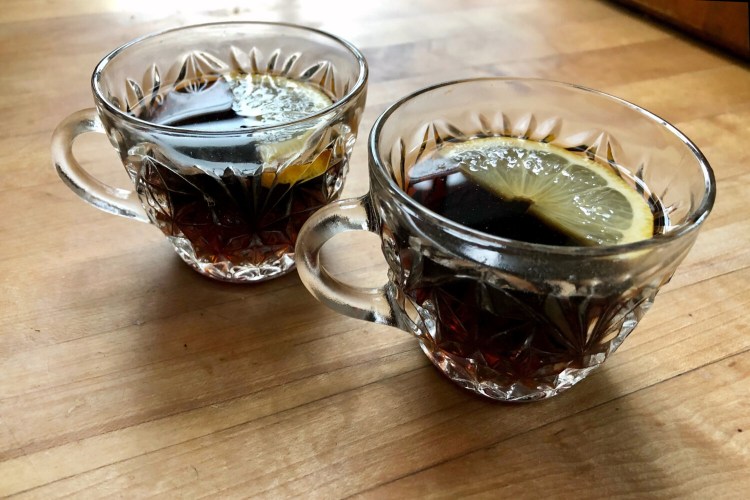There is something satisfying for a modern cook about looking at old recipes, particularly those mid-century American ones that took liberties with all manner of processed foods. Lime Jell-O with cheese? Assorted Oscar Mayer meats and wieners fashioned into Christmas ornaments and affixed to a Styrofoam tree? And so, so much Marshmallow Fluff.
There’s a lot going on in our revulsion over these kinds of concoctions: some genuine curiosity, definitely some confusion, but mostly a feeling of superiority. We would never, we like to tell ourselves (although the food lovers of the future looking back at our Dalgona coffees and unicorn toast would probably beg to differ).
And so when a vintage ad extolling the cold-weather joys of a hot Dr Pepper crossed my social media path, my initial reaction was the typical shudder-laugh-scroll-on. But wait, I thought, after seeing it a second time. Maybe they were onto something there, something worth hanging onto rather than casting onto the pyre of momentary mockery.
The idea didn’t sound that bad: After all, I’ve always had a soft spot for Dr Pepper. I don’t drink much soda these days, but when I do, it’s probably going to be an icy Dr P. I’ve always thought of it as a slightly more sophisticated sip than most of its brethren, with its complex, un-pin-downable flavor.
Curious about the origins of the drink, I asked the folks at Dr Pepper, who pointed me to a tale enshrined in the Dr Pepper Museum in Waco, Texas. According to company lore, the drink was first dreamed up by a salesman in 1958, who suggested it to the brand’s president, Wesby Parker, when he visited a bottling plant during a blizzard. After he “joked that they needed a hot drink to sell during winter weather since sales dipped so low,” per the museum, the company experimented with and eventually landed on the idea of heating the soda to 180 degrees and pouring it over a thin lemon slice.
The brand dubbed the concoction “Devilishly Different” and a “Winter Warmer” and eventually also promoted the “Schuss-Boomer,” (named after the term for a speedy downhill skier) which added rum to the mix. Apparently, at one point, the company teamed up with Bacardi to cross-market the cocktail, and you can still find vintage mugs emblazoned with an image of a skier and the name of the drink, accompanied by the two companies’ logos.
Hot Dr Pepper wasn’t just a flash in the company’s marketing pan. The company says that although its popularity eventually waned, hot Dr Pepper merchandise was still being sold “well into the 1990s.”
Curious to try it myself, I followed the dead-simple instructions: heat some Dr Pepper in a pan – some recipes provided by the company say until it reaches 180 degrees, others say merely “until steaming” – and pour it over a thin slice of lemon. The soda somehow still had a little of its effervescence when I poured it into a pair of my mom’s old cut-glass punch cups.
The drink was sweet, sweeter than I tend to like, but it was complex. Warming the liquid seemed to bring out some of the 23 flavors that Dr Pepper maintains as a proprietary secret (others have speculated that the list includes amaretto, caramel and clove) in a way that makes it feel particularly holiday-appropriate. The lemon added just a little bit of citrus to offset the sweet, though I found that adding a little more lemon juice toned down the cloying factor.
And to take the wintry mix to cocktail-land, I enlisted the help of Tiffanie Barriere, an Atlanta-based cocktail and beverage consultant who goes by the moniker of the Drinking Coach. Barriere didn’t turn up her nose at the idea. In fact, she praised the vintage concoction as “a tasty thing you should try.” She recommended a dark rum to pair with Dr P’s sweetness. “White rum tends to have a few spicy notes because it isn’t aged, while dark rum brings about caramel and brown sugar while aged in barrels,” Barriere said. “It makes a great cocktail.”
Send questions/comments to the editors.


